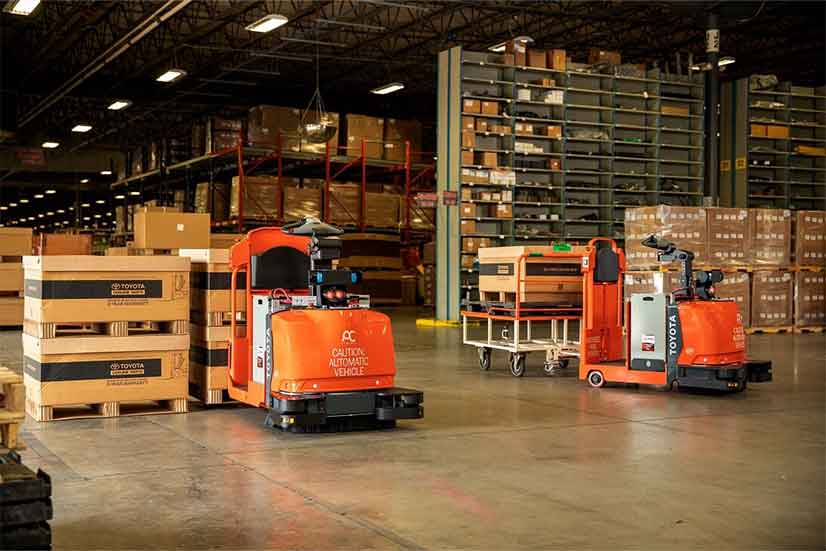Automated Guided Vehicles (AGVs) are reshaping the way industries operate, offering a bounty of benefits for those ready to embrace the future of automation. Learn how autonomous machines increase efficiency across various sectors and how you can introduce them into your operations with little or no infrastructure required.
Understanding AGVs
AGVs are self-operating mobile robots guided by sensors, cameras, and predefined routes or markers. They transport goods, materials, or products within a facility without human intervention. AGVs can come in various forms, from small, compact robots to larger, more specialized machines, depending on the application’s specific needs.
Six Ways AGVs Boost Efficiency
- Improved Workflow and Material Handling: AGVs excel in repetitive and time-consuming tasks like material transport. By deploying AGVs in a facility, companies can significantly reduce the time and effort spent moving goods from one location to another.
- Precise and Consistent Operations: AGVs operate with remarkable precision. They can follow predefined routes within millimeter accuracy, ensuring that materials are delivered to the correct location every time. This level of consistency minimizes errors and reduces the need for rework, ultimately improving overall efficiency.
- 24/7 Operations: Unlike human workers who need breaks and rest, AGVs can operate around the clock. This continuous operation capability means production can continue uninterrupted, increasing output and efficiency.
- Scalability: As businesses grow, their material handling needs often increase. AGV systems are easily scalable by adding more robots to the fleet. This flexibility ensures companies can adapt to changing demands without significant disruptions or delays.
- Safety and Reduced Downtime: Safety is a top priority in any industrial setting. AGVs use advanced safety features such as collision avoidance systems and emergency stop capabilities to help protect employees and minimize downtime due to accidents.
- Data-Driven Optimization: AGVs use sensors and cameras that collect valuable data about operations, including traffic patterns, cycle times, and resource utilization. This data helps identify areas for optimization and continuous improvement.
Applications Across Industries
AGVs are versatile and find applications across various industries:
- Manufacturing: AGVs transport materials to assembly lines, reducing idle time and increasing production rates.
- Warehousing and Distribution: AGVs efficiently move goods within warehouses, helping to meet the demands of e-commerce and same-day delivery services.
- Healthcare: AGVs are used in hospitals to transport medications, supplies, and linens, allowing healthcare professionals to focus on patient care.
- Automotive: AGVs help automotive plants deliver parts, support assembly lines, and transport finished vehicles.
- Agriculture: AGVs can automate crop harvesting and transportation in large-scale farming operations.
Toyota’s Automated Forklifts
Toyota’s Automated Forklifts rely on LiDAR-based natural features navigation, ensuring precise positioning and load delivery with accuracy tolerances of as little as half an inch.
What is the benefit for you? You won’t have to undergo the hassle of reorganizing your facility’s infrastructure or dealing with a complex setup process. We create a detailed map of the designated work area for the Toyota Center-Controlled Rider Automated Forklift, and the equipment takes care of the rest effortlessly.
Toyota currently offers two Automated Forklifts.
- Center-Controlled Rider Pallet Jack: Constructed upon the dependable foundation of the Toyota Center-Controlled Rider Pallet Jack, the groundbreaking Toyota Center-Controlled Rider Automated Forklift leverages state-of-the-art environmental sensing to automate repetitive warehouse tasks. Employing advanced sensors for cutting-edge mapped-object detection combines Toyota’s renowned warehouse equipment reliability with cutting-edge automation technology. This synergy results in cost reduction and operational streamlining for your facility.
- Core Tow Tractor Automated Forklift: The Toyota Automated Core Tow Tractor uses an advanced AC Drive System, AC Drive Motor, and regenerative braking capabilities. This powerful tow tractor significantly enhances productivity and is the perfect solution for horizontal material transport and cart pulling within your facility. Furthermore, each AGV in the lineup harnesses the power of LIDAR-based natural features navigation, reducing the need for extensive infrastructure or intricate setup procedures.
Learn more about Toyota’s Automated Forklifts and see them in action here: https://www.youtube.com/watch?v=kqhoxPySs4M.
AGVs represent a paradigm shift in industrial automation, offering many advantages to businesses seeking to enhance efficiency. If you are ready to embrace the AGV revolution and unlock the full potential in your operations, contact our automation experts to schedule a free consultation today.
Tags: automation, productivity, warehouse solutions
